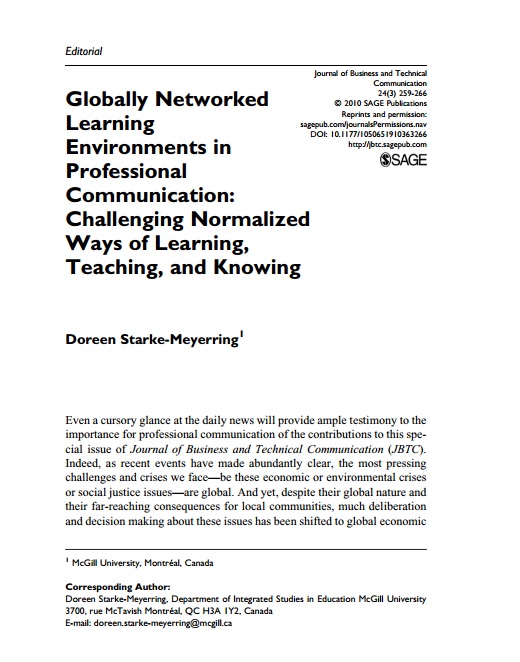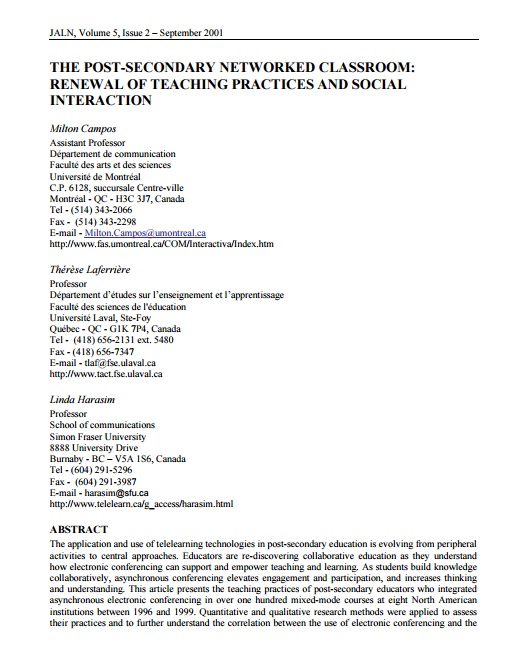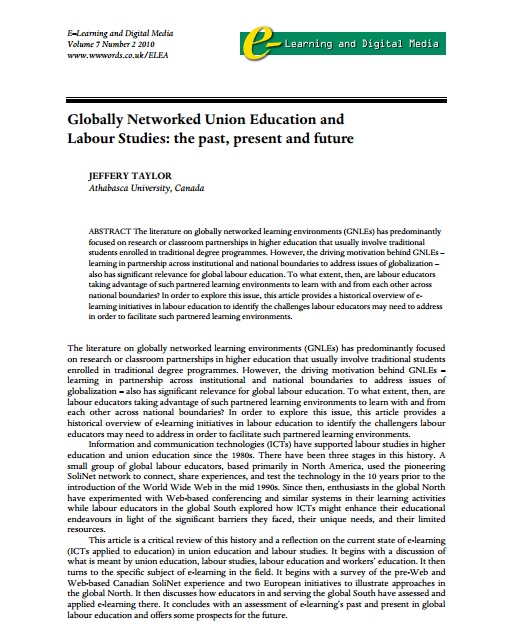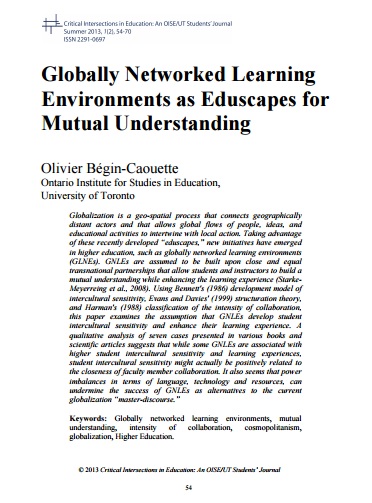Publications
This is a collection of scholarly articles and news articles on the topic of international, collaborative learning. This literature provides excellent overviews of this innovative model of teaching and learning, as well as its benefits and challenges.

Taylor, J. (2010). Globally Networked Union Education and Labour Studies: the past, present and future. E-Learning and Digital Media, 7(2), 172.
This paper examines the extent to which labour educators make use of partnered, global learning environments (GNLEs) in order to support learning and professional development. The author notes that while GNLEss have historically been primarily focused on traditional students in conventional degree programmes, there is a relationship between GNLEs and global labour education. The article presents a history of e-learning initiatives in global labour education, as well as a reflection of its current state. Based on this historical overview and reflection, the author identifies challenges which educators need to resolve in order to facilitate additional GNLEs.
Starke-Meyerring, D., Duin, A. H., & Palvetzian, T. (2007). Global Partnerships: Positioning Technical Communication Programs in the Context of Globalization. Technical Communication Quarterly, 16(2), 139–174.
This article examines the use of global partnerships to adapt technical communication programs to an increasingly globalized world. This article notes that there is an increasing need for technical communicators to develop skills in global citizenship in order to prepare for a global workplace. With focus on technical communication programs, the authors examine existing global partnership initiatives within these programs. The purpose of this study was to analyze established global partnership programs and assess their purposes, popularity, and challenges for participants of an exploratory web-based survey and follow-up interviews.
Bégin-Caouette, O. (2013). Globally networked learning environments as eduscapes for mutual understanding. Critical Intersections in Education, 1(2), 54–70.
This article examines the impact of GNLEs on students’ intercultural competencies and sensitivities. The author applies Bennett’s (1986) development model of intercultural sensitivity, Evans and Davies’s (1999) structuration theory, and Harman’s (1988) classification of the intensity of collaboration to his analysis of seven cases of GNLEs. His analysis suggests that intense collaboration and mutuality, particularly when instructors operate under a joint organization/initiative or follow the same institutional agreement, result in increased intercultural sensitivity.
Starke-Meyerring, D. (2010). Globally Networked Learning Environments in Professional Communication: Challenging Normalized Ways of Learning, Teaching, and Knowing. Journal of Business and Technical Communication, 24(3), 259–266.

The author’s introduction places the field of professional communication within the context of globalization, arguing that professional communication programs are advantageously positioned to shape social order and change. It asserts that the field of professional communication can help play an important role in advancing GNLEs in postsecondary education.
Starke-Meyerring, D. (2010). Globally networked learning environments: Reshaping the intersections of globalization and e-learning in higher education. E–Learning and Digital Media, 7(2).
This article is an analysis of the pedagogy from a classroom partnership pilot project connecting a management communication course in McGill University to another in the University of Delaware. Its purpose is to discuss challenges that were encountered and provide recommendations and guidance for future GNLE implementation and research. The author utilizes existing literature on business communication and its pedagogy in geographically-distributed settings to analyze and contextualize their project, focusing on the dynamics of team interactions, use of technology, and the classroom context.

Campos, M., Laferrière, T. and Harasim, L. (2001). The Post-Secondary Networked Classroom: Renewal of Teaching Practices and Social Interaction. JALN, 5(2).

This article presents a qualitative and quantitative examination of the use of asynchronous conferencing technologies in post-secondary courses, and its correlation to the level of collaboration occurring across networked classrooms. The authors examined 132 courses at eight post-secondary institutions in North America between 1996 and 1999. Through this study, the authors identified different ways for using conferencing technologies in teaching, and formulated a model for networked classrooms to advance collaborative teaching and learning.
Wilson, M. (2010). The Impact of Globalization on Higher Education: implications for globally networked learning environments. E-Learning and Digital Media, 7(2), 182.

This article reviews four books pertaining to GNLEs in the context of globalization: 1) “The WTO and the University: globalization, GATS, and American higher education”, by Roberta Malee Bassett; 2) “Prospects of Higher Education: globalization, market competition, public goods and the future of the university”, edited by Simon Marginson; 3) “The University, State, and Market: the political economy of globalization in the Americas”, edited by Robert A. Rhoads & Carlos Alberto Torres; and 4) “Knowledge Economy, Development and the Future of Higher Education”, by Michael Peters. The author argues that the process of implementing GNLEs must take into account issues relating to globalization and higher education.
One major issue discussed is the controversial inclusion of higher education within the General Agreement on Trade in Services (GATS). Bassett’s book examines the exclusion of public higher education institutions from the GATS negotiation process, and points out that global partnerships needed to create GNLEs should be based on curricula as opposed to global market trends or other requirements.
Marginson’s book aims to answer the question of whether emerging trends in globalization such as global university rankings might reinforce inequities across different universities. He suggests that global university rankings can threaten the equity of global partnerships if these partnerships take strategic alliances into account instead of desired curricula. Marginson also presents a framework to understand issues of globalization and the effects on higher education that the author of this review believes is suited to addressing key issues pertaining to GNLEs, such as who owns course dialogue, how freedom of expression is moderated, and what rules are for engagement and distribution.
Rhoads and Torres’ book focuses on Central and South America, and argues that decreased funding for public universities can have negative implications for equal global partnerships, as an imbalance is created when funding and infrastructure support is provided by institutions in the North. Furthermore, the authors point out that language is a barrier to equal partnerships: non-native English speakers may be disadvantaged in partnerships. Additionally, Rhoads and Torres advocate for an emphasis on social responsibility of universities in GNLE design.
News articles
Cook, K. (2009). Networked learning: Web conferences allow students to share knowledge and gain advice from experts globally. Nursing Standard.
Perez-Hernandez, D. (2014). Technology Provides Foreign-Language. The Chronicle of Higher Education.
Redden, E. (2014). Teaching with Tech Across Borders. Inside Higher Ed.


